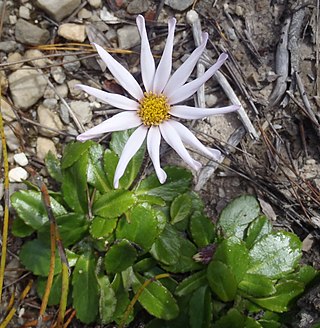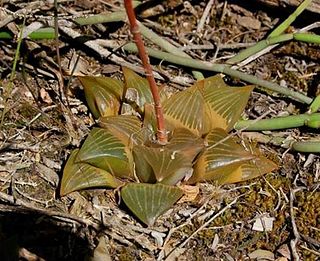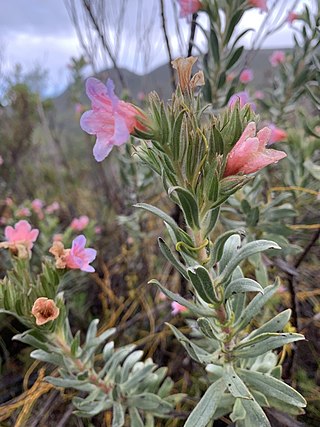
Mairia is a genus of perennial herbaceous plants assigned to the family Asteraceae. All species have leathery, entire or toothed leaves in rosettes, directly from the underground rootstock, and one or few flower heads sit at the top of the stems that carry few bracts. These have a whorl of white to mauve ray florets surrounding yellow disc florets in the centre. In general, flowering only occurs after the vegetation has burned down. The six species currently assigned to Mairia are endemic to the Western Cape and Eastern Cape provinces of South Africa. Some of the species are called fire daisy in English and vuuraster in Afrikaans.

Aloiampelos ciliaris, formerly Aloe ciliaris, the common climbing-aloe, is a thin, tough, rapidly growing succulent plant from South Africa.

Haworthia mirabilis is a species of the genus Haworthia belonging to the family Asphodelaceae.

Haworthia retusa is a species of flowering plants of the genus Haworthia in the family Asphodelaceae, endemic to a very small area around Riversdale, in the Western Cape Province in South Africa. Growing to 10 cm (3.9 in) tall and broad, it is a perennial succulent with thick triangular leaves and small white tubular flowers held in 50 cm (20 in) tall racemes.

Gasteria carinata is a small and variable succulent plant, native to the Western Cape Province, South Africa.
Tetragonia nigrescens is a plant native to southern Africa.

Leucospermum heterophyllum is a low, trailing evergreen shrublet of up to 15 cm (6 in) high, and up to several m in diameter, which is assigned to the family Proteaceae. It has narrow leaves of about 2½ cm (1 in) long and ½ cm (0.2 in) wide, mostly with three teeth near its tip. It has small, globe-shaped, whitish flower heads. It is called trident pincushion in English and rankluisie in Afrikaans. It naturally occurs in the Western Cape province of South Africa. The plant flowers between August and January.

Wahlenbergia capensis, commonly known as the Cape bluebell, is a plant in the family Campanulaceae and is native to the Cape Province but has been introduced to Australia. It is an annual herb with up to four greenish blue, bell-shaped flowers with spreading petal lobes.

Felicia tenella is an annual, sometimes biennial, herbaceous plant that may be slightly woody at its base, of 5–70 cm tall, that is assigned to the family Asteraceae. The species is very variable in size and hairiness. Its branches may be erect or ascending, and the leaves are narrowly line-shaped, 2–5 cm long and about 1 mm (0.04 in) wide. The leaves have a callous tip, lack visible nerves, and are mostly rigidly ciliate. The flower heads sit individually at the tip of stalks, have an involucre of three whorls of bracts, and about thirty light blue ray florets surrounding many yellow disc florets. Four subspecies are recognised. The species naturally occurs in the Northern Cape and Western Cape provinces of South Africa.

Trichodiadema pygmaeum is succulent plant of the genus Trichodiadema, native to the Western Cape Province, South Africa, where it is found in fine-grained soils in the regions of Bredasdorp and Swellendam.

Dianthus basuticus, called the Drakensberg carnation, Lesotho carnation, Lesotho pink, hlokoa‑la‑tsela in the Sesotho language and Lesothose wilde angelier in Afrikaans, is a species of Dianthus native to South Africa and Lesotho.

Lobostemon curvifolius, the largeflower healthbush, is a species of the forget-me-not family from South Africa.

Dianthus thunbergii is a species of flowering plant in the family Caryophyllaceae.
Selago aspera is a species of plant in the family Scrophulariaceae. It is endemic to the southern Cape Provinces, South Africa.

Wahlenbergia loddigesii is a herbaceous plant in the family Campanulaceae native to the southern Cape regions of South Africa.

Wahlenbergia nodosa is a herbaceous plant in the family Campanulaceae native to the dry karoo regions of South Africa.

Gazania rigida, the "Karoo Gazania", is a species of flower native to the Western Cape and Northern Cape Provinces of South Africa.
Acrodon deminutus, also known as the Malgas tiptoothfig, is a species of mesemb from South Africa.

Heliophila pusilla, the dainty sunspurge, is a species of plant in family Brassicaceae. It is endemic to the Cape Provinces of South Africa.
















